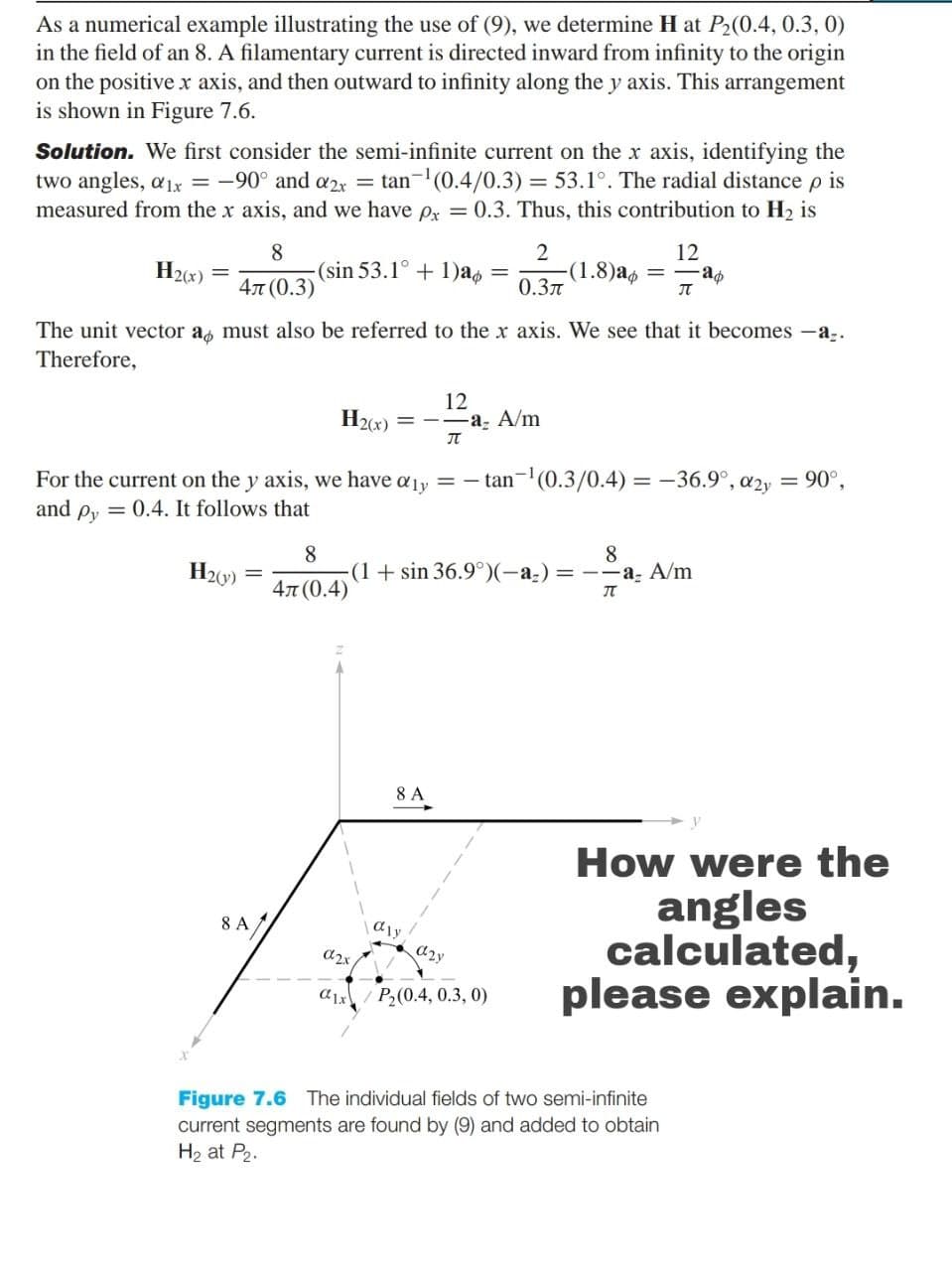As a numerical example illustrating the use of (9), we determine H at P₂(0.4, 0.3, 0) in the field of an 8. A filamentary current is directed inward from infinity to the origin on the positive x axis, and then outward to infinity along the y axis. This arrangement is shown in Figure 7.6. Solution. We first consider the semi-infinite current on the x axis, identifying the two angles, a 1x = -90° and a2x = tan¹(0.4/0.3) = 53.1°. The radial distance p is measured from the x axis, and we have px = 0.3. Thus, this contribution to H₂ is 8 2 12 H2(x) (sin 53.1° + 1)a -(1.8)ap = =-ap T 4л (0.3) 0.3 The unit vector a must also be referred to the x axis. We see that it becomes -a₂. Therefore, 12 H2(x) =-=a₂ A/m I For the current on the y axis, we have a ₁y = -tan-¹(0.3/0.4) = -36.9°, a2y = 90°, and p = 0.4. It follows that 8 8 H2₂(y) (1 + sin 36.9°)(-a₂) = --a₂ A/m 4л (0.4) π 8 A How were the angles calculated, please explain. 8 A aly azy α2x alx/P₂(0.4, 0.3, 0) Figure 7.6 The individual fields of two semi-infinite current segments are found by (9) and added to obtain H₂ at P₂.
As a numerical example illustrating the use of (9), we determine H at P₂(0.4, 0.3, 0) in the field of an 8. A filamentary current is directed inward from infinity to the origin on the positive x axis, and then outward to infinity along the y axis. This arrangement is shown in Figure 7.6. Solution. We first consider the semi-infinite current on the x axis, identifying the two angles, a 1x = -90° and a2x = tan¹(0.4/0.3) = 53.1°. The radial distance p is measured from the x axis, and we have px = 0.3. Thus, this contribution to H₂ is 8 2 12 H2(x) (sin 53.1° + 1)a -(1.8)ap = =-ap T 4л (0.3) 0.3 The unit vector a must also be referred to the x axis. We see that it becomes -a₂. Therefore, 12 H2(x) =-=a₂ A/m I For the current on the y axis, we have a ₁y = -tan-¹(0.3/0.4) = -36.9°, a2y = 90°, and p = 0.4. It follows that 8 8 H2₂(y) (1 + sin 36.9°)(-a₂) = --a₂ A/m 4л (0.4) π 8 A How were the angles calculated, please explain. 8 A aly azy α2x alx/P₂(0.4, 0.3, 0) Figure 7.6 The individual fields of two semi-infinite current segments are found by (9) and added to obtain H₂ at P₂.
Related questions
Question

Transcribed Image Text:As a numerical example illustrating the use of (9), we determine H at P₂(0.4, 0.3, 0)
in the field of an 8. A filamentary current is directed inward from infinity to the origin
on the positive x axis, and then outward to infinity along the y axis. This arrangement
is shown in Figure 7.6.
Solution. We first consider the semi-infinite current on the x axis, identifying the
two angles, α1x = -90° and a2x = tan-¹ (0.4/0.3) = 53.1°. The radial distance
P
is
measured from the x axis, and we have px = 0.3. Thus, this contribution to H₂ is
2
12
8
(1.8)ap
-ap
H₂(x)
-(sin 53.1° + 1)a
0.3л
J
4л (0.3)
The unit vector a must also be referred to the x axis. We see that it becomes -az.
Therefore,
12
H2(x)
=-=a₂ A/m
J
For the current on the y axis, we have any = -tan-¹(0.3/0.4) = -36.9°, a2y = 90°,
and py= 0.4. It follows that
8
H₂(y)
8
4л (0.4)
(1 + sin 36.9°)(-a₂) = -a- A/m
J
8 A
8 A
How were the
angles
calculated,
please explain.
α2x
P₂(0.4, 0.3, 0)
α1x
Figure 7.6 The individual fields of two semi-infinite
current segments are found by (9) and added to obtain
H₂ at P₂.
=
Expert Solution
This question has been solved!
Explore an expertly crafted, step-by-step solution for a thorough understanding of key concepts.
Step by step
Solved in 4 steps
